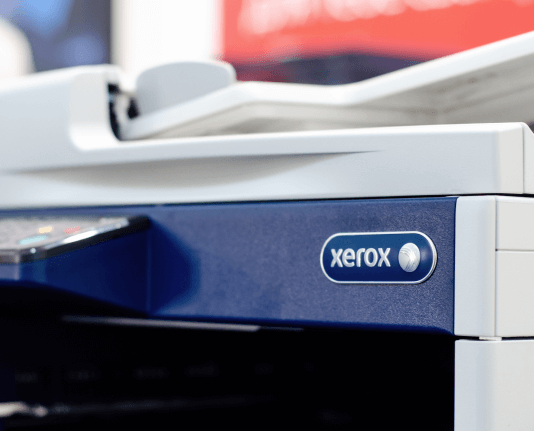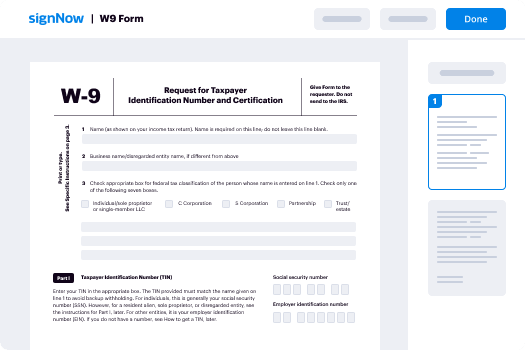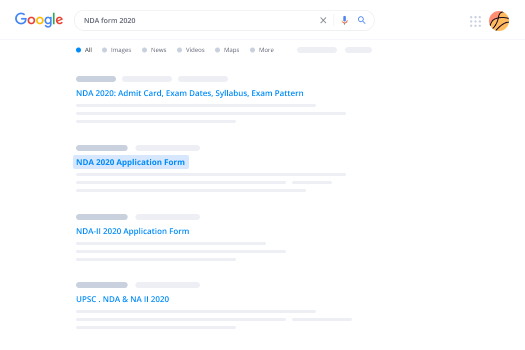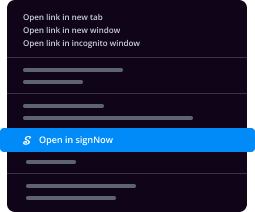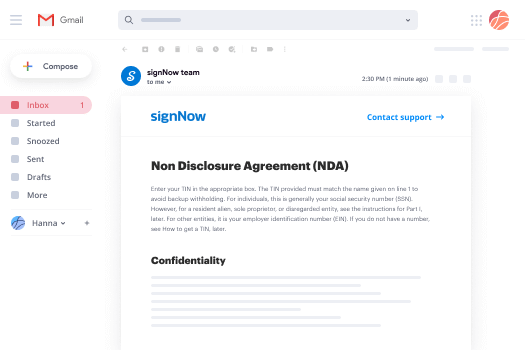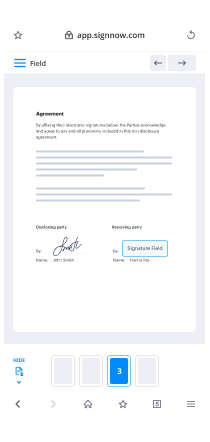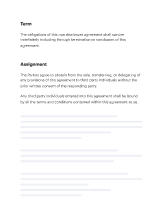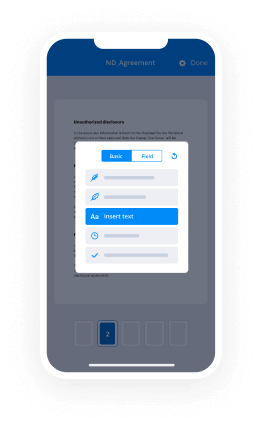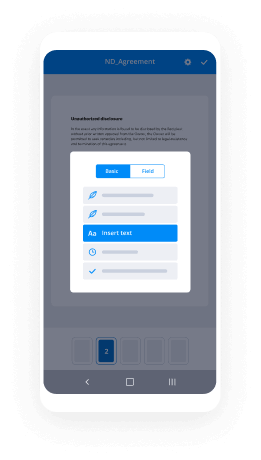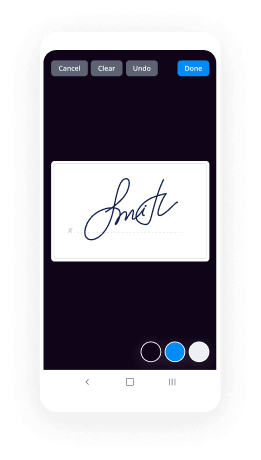Sign PDF for Procurement Mobile
Make the most out of your eSignature workflows with airSlate SignNow
Extensive suite of eSignature tools
Robust integration and API capabilities
Advanced security and compliance
Various collaboration tools
Enjoyable and stress-free signing experience
Extensive support
Keep your eSignature workflows on track
Our user reviews speak for themselves






Mobile Acquisition with airSlate SignNow
Mobile acquisition has revolutionized how companies handle their contracts and agreements. With airSlate SignNow, organizations can optimize the signing workflow, rendering it more effective and user-friendly. This guide will instruct you on how to utilize airSlate SignNow for your mobile acquisition requirements, ensuring you benefit from its many advantages.
Beginning with mobile acquisition using airSlate SignNow
- Launch your web browser and go to the airSlate SignNow homepage.
- Select to register for a complimentary trial or log into your current account.
- Choose the document you wish to sign or send for signing and upload it.
- If you intend to reuse this document, convert it into a template for subsequent use.
- Access your uploaded document and personalize it by adding fillable fields or inserting required information.
- Add your signature and specify designated areas for the recipients’ signatures.
- Click 'Continue' to set up the eSignature invitation and send it off.
Employing airSlate SignNow for mobile acquisition greatly enhances your document management processes. It offers a powerful platform that enables businesses to execute contracts seamlessly while ensuring compliance and security.
Begin transforming your acquisition process today with airSlate SignNow, a solution crafted for cost efficiency and user convenience. Experience exceptional support and straightforward pricing, making it the perfect option for SMBs and mid-market organizations. Register for your complimentary trial now!
How it works
Rate your experience
-
Best ROI. Our customers achieve an average 7x ROI within the first six months.
-
Scales with your use cases. From SMBs to mid-market, airSlate SignNow delivers results for businesses of all sizes.
-
Intuitive UI and API. Sign and send documents from your apps in minutes.
A smarter way to work: —how to industry sign banking integrate
FAQs
-
What is mobile procurement and how does it relate to airSlate SignNow?
Mobile procurement refers to the process of acquiring goods and services through mobile devices. With airSlate SignNow, businesses can streamline their mobile procurement processes by easily sending and signing documents on the go, ensuring efficiency and speed in transactions.
-
How can airSlate SignNow enhance my mobile procurement process?
airSlate SignNow enhances mobile procurement by providing a user-friendly platform that allows users to send, sign, and manage documents from any mobile device. This accessibility helps businesses reduce delays in approvals and increases productivity by enabling procurement activities anytime, anywhere.
-
What are the pricing options for airSlate SignNow's mobile procurement solutions?
airSlate SignNow offers various pricing plans to accommodate different business needs and sizes. Each plan includes features tailored for mobile procurement, ensuring you get the best value for your investment, whether you are a small business or a large enterprise.
-
Can I integrate airSlate SignNow with my existing mobile procurement tools?
Yes, airSlate SignNow seamlessly integrates with a variety of popular mobile procurement tools and platforms. This capability allows you to enhance your existing workflows and ensures a smooth transition to a more efficient document management process.
-
What features does airSlate SignNow offer for mobile procurement?
airSlate SignNow offers features specifically designed for mobile procurement, including customizable templates, real-time tracking of document status, and secure eSignature capabilities. These features help streamline the procurement process and ensure compliance and security.
-
Is airSlate SignNow suitable for businesses of all sizes in mobile procurement?
Absolutely! airSlate SignNow is designed to cater to businesses of all sizes, making it an ideal solution for mobile procurement. Whether you're a startup or a large corporation, our platform can scale to meet your procurement needs efficiently.
-
How does airSlate SignNow ensure the security of mobile procurement documents?
Security is a top priority for airSlate SignNow. We implement industry-standard encryption protocols and provide secure access controls to protect your mobile procurement documents. This ensures that your sensitive information remains confidential and safe from unauthorized access.
-
What is the next wave of innovation in e-commerce after flash sales and private sales?
Ok, I have thought about this a lot having worked on a business plan/model in this space. The next great ecommerce phenomenon will be:FUN. Like not just fun because you got a great deal, or the site has great marketing and is Flashy. Hanging out with your friends at the mall when you're 14 years old was probably the last time you had a FUN experience that involved consumerism. And do you realize it was fun even though you had maybe $18 to spend on something shitty from Anchor Blue or that one pink and black chain (I forgot the name) that sold vaguely adult products. Now all your experiences online or offline are tinged with the maniacal pressure to get the best F-ing deal on the planet, or the sublimated guilt of spending more money than you really feel comfortable doing on some "brand", but hey it's Amazon Prime and it will be here in 36 hours so it's OK! Neither of these scenarios are really pure FUN FUN FUN 'till your daddy takes your T-Bird away.PRODUCT DRIVEN. Both in the sense that the site will be a PRODUCT that the web hasn't seen before: not just a marketing or business model gimmick, or smartly targeted audience segment, or whatever. And in the sense that the PRODUCTS you buy will be front and center in the experience.Will CHANGE what "buying" actually MEANS. Every ecommerce business model I've seen to date actually underwhelms because it aims far too low. The point of the web is that it makes it possible to actually change the definition of vocabulary words we use day in and day out through novel experiences. But all these fancy deal-a-day-private-sale-curated sites still mean "buying" when they say "buying". Thats boring!Will be acutely aware of MIMETIC DESIRE and the full implications of Rene Girard's thinking on modern consumer behavior.So that's my tease about what I think/know the next phenomenon will look like, at least in my imagination. Peace out!
-
Why is the Chinese military viewed so poorly by western countries?
People, listen.The word military comes from the Latin word: militaris meaning soldier.I’ve never been in any military organisation of any countries in the world. However, I can say with confidence that a soldiers duty is to protect and serve the very people that lives in his or her country. We've been so clouded and de-sensitised by statistics thrown from left right and centre.The US: “Carriers”.The UK: “Trident”.Russia: “Nuclear Weapons”.“10,000 soldiers with state of the art equipment enters…” we've all heard it.My point is, yes, people underestimate the Chinese military not because of how many tanks or attack helicopters they have, but they underestimate their call of duty: “Service for the People”.This doesn't mean invading other countries to keep the people ‘free’ at home!This means being their for the times that count, for when your ordinary Joe is crying because his building burnt down, or there was an earthquake. For the times when old ladies are trapped under rubble becuase of disasters. For the times when you hear “thank you” because you didn't risk your life to take a bullet, instead you did what counts. You helped your fellow man.Stop, guys, by no means am I a hippie, nor a warmonger, I'm just someone trying to shed light on what the PLA are actually doing.They do not just call your local donut-eatin’ officer to handle this. This is true service.In 2015, I went to an earthquake memorial in Sichaun, and at first I was skeptical. I was solemn but all I saw were numbers. Until a friend told me that not only were entire towns and villages rebuilt, PLA soldiers stayed behind, on their own accord, to farm with the farmers. Though buildings are rebuilt, sons and daughter. Fathers and mothers cannot be replaced. They understood that, because they were not some “folks born with silver spoon In hand”, they stayed and helped. They did what they did. Ate what they ate.This is the true call of duty.Not to go to some foreign soil and make fun of foreign languages and wave guns about.“Hoo-rah” and “Get the F*** down”.Stop placing military might on such a high pedestal, because there was a time, when people remember what militaries are for. China has not forgotten, and I believe it will continue to dedicate themselves for their people.Wars are not fought just with guns, and true militaries know their purpose.“为人民服务““Service for the People”Don’t underestimate that.EDIT:The experience I had in 2015 was a massive eye opener and it made me realise what armies are for. Sure, they carry guns, but it's not to harm people, rather to protect as a last resort. Also, the PLA soldiers understood and empathised because they've been there. Look at their skin. It's brown, and trained. It's not just from the army, most of them ARE farmers.EDIT EDIT:In response to recent quorans questioning whether or not I answered the question, I did, you just weren't looking in the right direction. As I've said again and again what the purpose of a military is, I cannot simply scrape Wikipedia info on who's got the most nuclear bombs, as that doesn't do justice to true militaries. Let me reiterate, I did answer the question, just LOOK.Cheers guys.EDIT EDIT EDIT:The fact that there are 4 US soldiers in the pictures, it doesnt diminish the point Im trying to make. The point is that people misunderstand the purposes of military and it's great the US boots are there. I'm trying to show, that China has set foot in foreign countries, in terms of warfare. It's getting a bad rep and consistently undermind for the lack of technology put into tanks or airborne forces, but everyone seems to want to focus on the bad side.Yeah, I am biased, and why shouldnt I be? No one in this world is truly objective. However, don't misunderstand, yet again, this isn't a PR speech, Im just answering a question in a different way, a different perspective. As I feel the throughout the bloodshed, alot militaries forget that their duty is to their own people, and not to do so by bullying smaller countries.
-
What is the future of fintech?
Given where I work, I’ll focus on fintech in Africa.Mobile money was a boon for fintech in Africa. Since the launch of MPESA in 2007, mobile money has been the main fintech driver in Sub Saharan Africa.That’s not to say fintech didn’t exist in Africa before 2007. Direct carrier billing, reverse SMS billing, airtime billing, mobile banking and other forms of consumer focused “fintech” have existed for a while. My first company helped businesses implement carrier-enabled billing, among other things.But all these services felt like workarounds, bolt-ons that weren’t easy to understand or explain. Try explaining reverse carrier billing to a farmer trying to sell two cows in Western Uganda.They also didn’t work for transferring value. Mobile money reduced this cognitive friction for consumers. It was money. On your phone. Plain and simple.With that, here are a few of my opinions on the trends in the payment space which will drive what happens to fintech:Mobile money agents were the first gig economy & are here to stay.Mobile money agents are human ATMs. It’s on their backs that mobile money was built. It’s because of them that you trusted mobile money. They enable liquidity — the basic requirement of any currency. You could cash out when you needed to, using their own money. Mobile money agent networks are expensive to set up and maintain. And they’re here to stay, for the time being. They’re how money gets into/out-of the system and until there’s a replacement as extensive as these networks of agents, they will still be the kings of the last mile. Because of these 500M-odd agents sprinkled across Africa, mobile money will continue to play an important role in fintech for the next few years. And fintech companies that build and maintain agent networks will continue to be important in the near term. (Zoona and Pagatech come to mind.)E-payments will become a key target for disruption.The top activity on mobile wallets is peer-to-peer transfers. The second is cash-out by a large margin. E-payments are a distant third. We will see less cash-out activity over time. As mobile money and other forms of electronic cash become more widely accepted by merchants, and as people become more comfortable with cash that they cannot see, touch, feel and count with their hands, then they will be less likely to cash out and more likely to keep e-value. This may diminish the value of agent networks over time, and give rise to other forms of e-value (block-chain based, closed wallet eco-systems, etc). Peer to peer payments will still be the top activity on these e-value systems, but at some point in the future, e-payments will overtake cash-out as the number 2 activity. Interestingly, everyone wants this to happen sooner rather than later because cash-out is expensive (agent networks are expensive to setup and run).Non telecom-led wallets will continue to riseand with them, a new breed of fintech companies that aren’t tethered to telecom companies. Telecom companies have a head start, but two things will reduce this lead over time: e-payments overtaking cash-out (already mentioned) and the rise of smart-phones. The increase in smartphone penetration (already at critical mass) means that you don’t need a sim-card to transact. You don’t need to use your telecom provider’s mobile money wallet. It will be possible for third party, non telecom-led wallets to flourish. Fintech companies are already popping up that provide various forms of non telecom-led wallets. I think the most likely candidates are the chat apps (Whatsapp, WeChat, etc) that will turn on payments in Africa at some point in the future.Banking will go digitalAlready, there are some companies working on digital banks in Africa. We’ll see these rise. And at some point, the difference between a bank account and a mobile money wallet shall disappear. A mobile money wallet will be an extension of someone’s bank account or vice versa. Interestingly, mobile banking existed long before mobile money did as an extension of a user’s bank account (my first company provided such technology for banks) - we’ll see a return to this: where your bank account and mobile wallet are indistinguishable, unless you choose a different provider for each service.Centralized credit scoring databases will emerge. Micro-loans and micro-credit have boomed over the past 5 years, on the backs of some of the trends above - for example: using smartphone data to generate credit scores and reduce risk. However, the siloed nature of these companies means that people literally borrow from one to pay the other (or to pay mobile gambling debts). This is unsustainable and will be the primary driver behind creation of centralized credit reference bureaus. In fact, more than one government and many private fintech companies are working to develop these databases.A lot else will happen:Decentralized payments: We’ll figure out in 5 years whether blockchain plays a bigger role in fintech on the continent, and whether that’s a backend infrastructure role or a e-currency role. Players like Facebook entering the game are certainly interesting.On the opposite side of the spectrum: We’ll also figure out whether Mojaloop is the platform of choice for centralizing payment service provider interconnectivity. The powers behind it are driving serious adoption, so it may well emerge as the de-facto standard for low cost interoperability. Only time will tell.All in all, fintech in Africa is a dynamic and exciting space. Lots of opportunity, lots of change, lots of sleeping giants. This is what I love about working in this space - certainly not boring!
-
What is new strategy for SEO in 2019?
First, you should know about interstitials…According to the Google Webmaster Central Blog, “to improve the mobile search experience, after January 10, 2017, pages where content is not easily accessible to a user on the transition from the mobile search results may not rank as highly.”If you’re not an SEO nerd, this basically means that sites with mobile popups—or what Google calls “interstitials”—may be penalized.Any sort of potential penalty obviously doesn’t bode well for your website, so it’s important to understand the details of this impending update and whether you’re likely to be affected.Here is what you need to know to make sure you’re not adversely impacted.What are interstitials?First things first. Just what is Google talking about when it refers to interstitials?The formal definition from Tech Target is this:“An interstitial (something ‘in between’) is a page that is inserted in the normal flow of editorial content structure on a website for the purpose of advertising or promotion.”You’ve seen these before, right? You’re tap-tapping along, and then boom!—a popup.Unlike other types of ads, e.g., banner ads, interstitials require the user to manually click/tap on the ad or click/tap on the “x” (close) button.You’re basically prevented from exploring a website until you comply and click on a link or “x.”This is obviously disruptive, and many people (including Google) feel that it detracts from the overall user experience.Here are three different examples Google specifically mentions that make content less accessible:Google also provides some examples of techniques that make content less accessible to a user:“Showing a popup that covers the main content, either immediately after the user navigates to a page from the search results, or while they are looking through the page.”“Displaying a standalone interstitial that the user has to dismiss before accessing the main content.”“Using a layout where the above-the-fold portion of the page appears similar to a standalone interstitial, but the original content has been inlined underneath the fold.”Not everything that seems like an interstitial is actually an interstitial. Cookie permissions, age verification, and small banners are all okay in Google’s eyes.What you need to doIn my opinion, it’s best to err on the side of caution in situations like these.The last thing you want is for your rankings to take a major hit because of interstitials.I would recommend removing any popups or intrusive ads at least for the time being until the dust settles.If using interstitials has been a key piece of your revenue model, I would suggest considering alternative options.What are the alternatives?Your best bet would be replacing a popup with a banner ad.According to Google, one technique that won’t be affected by the new signal is “banners that use a reasonable amount of screen space and are easily dismissible. For example, the app install banners provided by Safari and Chrome are examples of banners that use a reasonable amount of screen space.”Usually, the ideal positioning for a banner ad is at the top of the screen, where it’s very noticeable but doesn’t detract from the user experience.You can still use a considerable amount of screen space to grab the attention of visitors as long as it’s not overly intrusive.When done correctly, a well-placed banner ad should still generate a good number of clicks and ensure that visitors are aware of your offers.Another possibility is a stationary sidebar ad. These tend to work well because they’re still noticeable even after a visitor scrolls down your site.Even when it’s below the fold, a sidebar ad will continue to appear, increasing your chances of getting clicks.But what if I absolutely have to have pop-ups?If you feel like skipping popups altogether is going to kill your conversions, there is a third option: the time-driven popup.Such a popup ad will only appear after a visitor has been on your site for a certain amount of time and explored your content to some extent.Unlike a regular popup, where a visitor is hit instantaneously after arriving on your site, this delayed popup ensures they have at least some level of interest and be more open to an offer.However, I would still exercise caution with this technique because there is the potential for penalties.Next, you should know about Possum…One of the more signNow updates Google made in late 2016 was Possum.In fact, it’s arguably the biggest change Google has made to local SEO since the Pigeon update back in 2014.As you might imagine, it’s shaken things up quite a bit and has switched up the SEO landscape considerably.The first thing you’re probably wondering about is why exactly the SEO community called it Possum. Google usually names their updates after animals, but a possum isn’t as cute as a penguin or as awe-inspiring as a panda. Possum? Really?Well, the term was coined by Phil Rozek.According to Search Engine Land, “Rozek suggested the name, pointing out that it is fitting since many business owners think their Google My Business listings are gone, when in fact they are not. They have just been filtered—they’re playing possum.”Okay, so the possum name is supposed to make you think of something playing dead when really, it’s not dead.It all went down on September 1, 2016.Although it was never actually confirmed by Google, it was clear that a major change had occurred that specifically impacted the 3-pack and Local Finder, which you probably know better as the local results or Google Map results.All of a sudden, many of the websites that had ranked so well for so long had lost traction and saw a dip in their rankings.However, other sites that once had difficulty ranking saw a noticeable spike in their rankings.To get a better idea of the implications, it’s helpful to take a look at some data from an article published on Search Engine Land.In an attempt to determine precisely how big of an impact Possum had on local search, Search Engine Land signNowed out to Bright Local to conduct a study.In this study, Bright Local “took a look at the ranking trackers for 1,307 different businesses, which were tracking 14,242 keywords. Then they compared the difference between September 7 and August 31 (the date before Possum).”Here’s what they found:9% of the keywords had the business pop into the Local Finder when they weren’t there previously.11% of the keywords showed the business had increased in position by three or more positions.15% of the keywords showed the business had increased in position by one to two positions.35% of the keywords showed no change in position for the business.15% of the keywords showed the business had decreased by one to two positions.14% of the keywords showed the business had decreased by more than three positions.Here’s a graph to illustrate how this all breaks down:What does this mean for local SEO?Perhaps the most noticeable change was that businesses that aren’t located directly within the city limits now have a much better chance of ranking well.Here’s an example:Say there’s an Italian restaurant located in Hialeah, Florida. It’s very close to Miami but not located within the city limits.Prior to Possum, that restaurant would have had difficulty ranking for keywords such as “Italian restaurant Miami” or “Miami Italian restaurant.”But now, after Possum, that restaurant has a chance to rank for those keywords.And this makes sense when you think about it.Why should businesses very close to the city suffer just because they’re not exactly within the city limits?Odds are, many of those businesses would be just as relevant to the searchers as others located directly within a city.This recent update basically levels the playing field between businesses located right within a city and businesses located in the suburbs and other surrounding areas.As long as a business is within a close proximity to a city, it has the chance to rank when that city’s name is used in a search query.In my opinion, this is a logical move that will be beneficial in the long run. This spreads the wealth and ensures that search engine users find exactly what they’re looking for.IP address is a bigger factorIn the past, what popped up in search results was primarily based on the entered keywords.But with Possum, Google will now take a search engine user’s IP address into account when generating search results.This is Google’s way of ensuring users get the most accurate results when performing a search.The main reason for this change is the massive volume of people using mobile devices.Google is continually looking for new ways to accommodate mobile search users.Because people are often on the go, this ensures they’re always getting the best results based on their current location.This is something you’ll want to keep in mind and use to guide your local SEO approach.I think that Inc offers a smart suggestion:“Your QA team should test your work as a user within the region of the business and not simply test it by Googling the business name and location.”Doing so should definitely give you an edge over competitors still basing their strategy primarily on keywords (an outdated strategy as this point).There’s more variance in search results based on keyword selectionBefore the Possum update, users could enter similar keyword phrases and get virtually the same results.For instance, entering “Italian restaurant Miami,” “Miami Italian restaurant,” or “Italian restaurant Miami FL” would generate pretty similar results.But that’s no longer the case.In fact, there could be a considerable variance depending upon the specific keywords a user enters.Let’s look at an example.Here are the results I got when I used “Italian restaurant Miami” as a keyword phrase:And here’s what happened when I used “Italian restaurant Miami FL” as a keyword:Notice by simply adding “FL” at the end, I got completely different results. Pretty interesting.This just goes to show that Google is “spreading the wealth,” and even a small keyword nuance can produce entirely different results.
Trusted esignature solution— what our customers are saying
Get legally-binding signatures now!
Related searches to Sign PDF for Procurement Mobile
Frequently asked questions
How do i add an electronic signature to a word document?
How to create electronic signature image?
How the hell do i esign a webpage?
Get more for Sign PDF for Procurement Mobile
- Can I eSignature Ohio Lawers Lease Termination Letter
- Can I eSignature Oregon Non-Profit Last Will And Testament
- Can I eSignature Oregon Orthodontists LLC Operating Agreement
- How To eSignature Rhode Island Orthodontists LLC Operating Agreement
- Can I eSignature West Virginia Lawers Cease And Desist Letter
- eSignature Alabama Plumbing Confidentiality Agreement Later
- How Can I eSignature Wyoming Lawers Quitclaim Deed
- eSignature California Plumbing Profit And Loss Statement Easy
Find out other Sign PDF for Procurement Mobile
- Mortgage application form 61929
- Verification of rent vor form
- Commercial lease agreement template download form
- Lease mooring form
- Lease pdffiller form
- Tar 2003 10 14 03 form
- Application for transfer of lease of a sold stall app2 nea gov form
- Lease application form co edward rose amp sons
- Njar form 123
- Commercial rental application form
- Docslaese form
- Prds application to rent or lease form
- Commercial lease application form pdf
- Dl61 dmv form
- Ctc 41 4 form
- Foster application form
- Employment application form
- Alaska certificate of fitness asbestos form
- Omb no 0579 0052 form
- J vccb form

